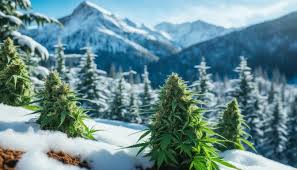Introduction
For cannabis enthusiasts in colder regions, the dream of cultivating their own potent buds doesn’t have to be put on hold. While cannabis thrives in warm, sunny climates, with a little extra planning and know-how, successful germination and growth are achievable even in chillier environments. This guide explores the specific challenges and strategies for germinating cannabis seeds in cold climates, ensuring your green thumb flourishes year-round.
Which Countries Face Cold Climates?
“Cold climate” is a relative term. Places like Canada, Russia, northern Europe, and parts of the United States experience significant temperature drops during winter months, often dipping below freezing. Even regions with milder winters can have cool spring and fall seasons that pose challenges for seed germination.
Challenges of Germinating in Cold Climates: What Makes it Difficult?

There are two main hurdles to overcome when germinating cannabis seeds in cold climates: temperature and humidity fluctuations.
- Low Temperatures: Cannabis seeds germinate best within a specific temperature range, typically between 68-77°F (20-25°C). Colder temperatures slow down this vital process, reducing germination rates and potentially leading to weak seedlings.
- Humidity Fluctuations: Maintaining consistent humidity is crucial for seed germination. Cold environments often experience drier air, which can dry out the seeds and hinder their ability to sprout. Conversely, overly humid conditions can promote mold growth.
Read- Choosing Healthy Cannabis Seeds: A Guide to Successful Cultivation
How Cold Affects Germination and Seedling Health
- Reduced Germination Rates: Colder temperatures slow down the metabolic processes within the seed, making it harder for them to sprout. This can lead to extended germination times or even failed germination attempts.
- Weak Seedling Development: Seeds that do germinate in cold conditions may produce weak seedlings with stunted growth. These seedlings are more susceptible to disease and may struggle to thrive as they mature.
- Uneven Germination: Temperature fluctuations within the germination environment can lead to uneven germination, with some seeds sprouting much later than others.
Impact of Cold on Germination Methods
The two most common cannabis seed germination methods, paper towel and direct sowing, are both affected by cold weather in different ways:
- Paper Towel Method: This method relies on maintaining a consistently moist environment. Cold temperatures can slow down the evaporation process, potentially leading to waterlogged seeds which can rot.
- Direct Sowing: Sowing seeds directly into soil offers less control over temperature and humidity compared to the paper towel method. Cold soil temperatures can significantly hinder germination, and fluctuating temperatures can dry out the soil prematurely.
Strategies for Overcoming the Cold: Creating the Perfect Environment
Now that we understand the challenges of cold climates, let’s explore strategies to ensure your cannabis seeds germinate successfully:
- Ideal Temperature Range: Aim for a consistent temperature range between 68-77°F (20-25°C) during germination. This might involve using tools to create a warm microclimate for your seeds.
- Heat Mats: Heat mats provide a gentle and constant source of warmth from below, mimicking the ideal soil temperature for germination. Place the germination container on top of the heat mat and monitor the temperature with a thermometer to avoid overheating.
- Humidity Domes: Humidity domes trap moisture around the germinating seeds, preventing them from drying out. This is especially helpful in cold climates with drier air. You can create a makeshift dome using a clear plastic container with ventilation holes poked in the top.
Lighting Considerations for Cold Weather Germination
While not strictly essential for germination, providing supplemental lighting can be beneficial in cold climates. Here’s why:
- Extended Daylight Hours: During colder months, natural daylight hours are shorter. Supplementing with fluorescent lights for 16-18 hours a day can mimic longer days and potentially improve germination rates.
- Seedling Strength: Some growers believe that supplemental lighting can help seedlings develop stronger and healthier by promoting photosynthesis even during shorter days.
Choosing the Right Equipment
Equipping yourself with the proper tools can significantly increase your success rate when germinating cannabis seeds in a cold climate. Here’s a breakdown of essential and helpful equipment to consider:
Essentials:
- Propagation Tray: Opt for a small, shallow tray specifically designed for seed germination. These trays often feature drainage holes and a clear plastic lid that can be used as a makeshift humidity dome.
- Heat Mat: A reliable heat mat provides a gentle and consistent source of warmth from below, mimicking the ideal soil temperature for germination (68-77°F / 20-25°C). Choose a mat that’s the same size as your propagation tray for even heat distribution.
- Humidity Dome: A humidity dome helps retain moisture around the germinating seeds, preventing them from drying out in cold, dry environments. Look for a dome that fits snugly on your propagation tray and has adjustable vents for proper air circulation.
- Thermometer: Monitoring temperature is crucial. A small digital thermometer with a probe allows you to accurately measure the temperature within your germination environment and ensure it stays within the optimal range.
- Light Source (Optional): While not essential for germination, a fluorescent or LED grow light can be beneficial in cold climates with shorter daylight hours. Providing 16-18 hours of light daily can mimic longer days and potentially improve germination rates and early seedling growth.
Helpful Extras
- Hygrometer: Measuring humidity levels alongside temperature provides a complete picture of your germination environment. A digital hygrometer helps you ensure consistent humidity, ideally around 70% during germination.
- Seedling Heat Lamp: Once seedlings emerge, a seedling heat lamp positioned a few inches above them can provide additional warmth, especially during the first few days after germination when they’re more vulnerable to cold stress.
- Seed Starting Mix: Using a sterile, well-draining seed starting mix specifically formulated for seedlings is recommended. This ensures proper aeration and avoids introducing pathogens that could harm your delicate seedlings.
- Spray Bottle: A mister or spray bottle filled with clean water allows you to gently mist the germination dome and keep the environment humid without overwatering the seeds.
Seedling Care in Cold Climates: Keeping Your Young Plants Thriving
Once your cannabis seeds have successfully germinated, proper care is essential for healthy seedling development, even in cold climates. Here’s what you need to know:
- Hardening Off Seedlings: Before transplanting seedlings outdoors, a hardening-off process is crucial. Gradually expose them to cooler outdoor temperatures and fluctuating light conditions over a week or two. This helps them adapt to the harsher environment and reduces the risk of cold stress.
- Signs of Cold Stress: Wilting, stunted growth, and purplish discoloration on leaves are all signs that your seedlings are experiencing cold stress. If you notice these symptoms, act quickly to provide warmth and protection.
- Watering and Feeding Needs: Cold weather can slow down a seedling’s growth rate, impacting its water and nutrient requirements. Water sparingly to avoid overwatering, and adjust your feeding schedule to a weaker nutrient solution compared to warmer climates.
Choosing the Right Cannabis Strain
Not all cannabis strains are created equal. When germinating in cold climates, consider these factors when choosing seeds:
- Cold Resilience: Some strains are naturally more resistant to colder temperatures and shorter growing seasons. Look for strains known for their hardiness, such as Hindu Kush or Ruderalis lineages.
- Autoflowering Strains: Autoflowering strains have a predetermined flowering cycle triggered by age rather than light. This is advantageous in cold climates with shorter summers, as they can mature before the first frost arrives.
- Local Success Stories: Research cannabis strains that thrive in your specific geographic region. Talking to local growers or consulting online forums can provide valuable insights into which strains perform best in your cold climate.
Additional Tips and Considerations
- Alternative Germination Methods: Some growers have found success with alternative germination methods like the “cup of water” technique. However, these methods require close monitoring to avoid drowning the seeds.
- Greenhouse Advantage: Utilizing a greenhouse can provide a controlled environment with warmer temperatures and protection from harsh weather elements. This can be particularly beneficial for starting seeds early and extending the growing season.
- Specialized Tools: Investing in a thermometer and hygrometer allows you to monitor temperature and humidity levels precisely, ensuring optimal conditions for germination and seedling growth.
Conclusion
Germinating cannabis seeds and cultivating healthy plants in cold climates requires extra planning and attention to detail. By following these strategies and utilizing the right tools and strains, you can achieve successful cannabis cultivation even in chillier regions. Remember, with a little extra effort and knowledge, you can cultivate your own potent buds and enjoy the rewards of your green thumb all year round.
